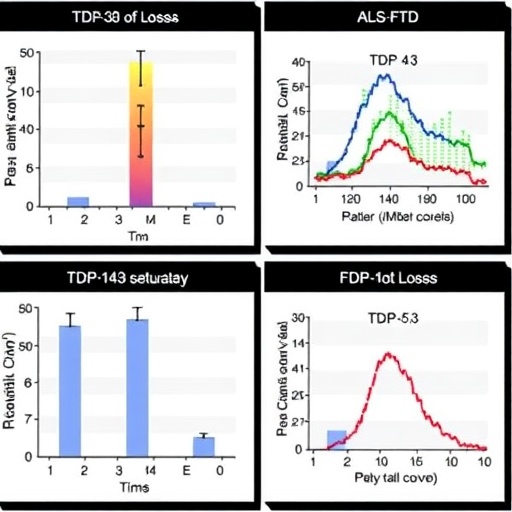In a groundbreaking study published in Nature Neuroscience this year, researchers have uncovered a novel molecular mechanism that sheds light on the pathological complexities of amyotrophic lateral sclerosis (ALS) and frontotemporal dementia (FTD). The team led by Bryce-Smith et al. has provided compelling evidence that the loss of the RNA-binding protein TDP-43 triggers aberrant cryptic polyadenylation events, contributing to the neurodegenerative cascade characteristic of these devastating diseases. This new insight not only deepens our understanding of RNA metabolism disruptions in neurodegeneration but also opens promising avenues for therapeutic intervention targeting RNA processing pathways.
TDP-43, a multifunctional protein involved in RNA splicing, stability, and transport, has long been recognized as a pivotal player in neurodegenerative diseases. Its aggregation and cytoplasmic mislocalization have been documented across the majority of ALS and FTD cases, yet the precise consequences of its depletion at the molecular level have remained incompletely defined. Bryce-Smith and colleagues have now uncovered that TDP-43 loss leads to widespread activation of cryptic polyadenylation sites within pre-mRNA transcripts, resulting in truncated, aberrantly processed RNAs that may exert toxic effects or disrupt normal cellular function.
The concept of cryptic polyadenylation involves the utilization of unexpected polyadenylation signals within intronic or untranslated regions, which prematurely stop transcription and destabilize transcripts or alter their coding potential. This process had previously been suspected as a contributor to altered RNA landscapes in neurodegeneration, but direct causative links remained elusive. The current study rigorously demonstrates through RNA sequencing and molecular assays that TDP-43 normally suppresses these cryptic sites, maintaining transcriptome integrity. Loss of this suppression unleashes cryptic polyadenylation genome-wide, severely perturbing normal gene expression programs.
The investigative team employed state-of-the-art transcriptomic profiling of human neuronal models depleted of TDP-43, combined with post-mortem brain tissue analyses from ALS and FTD patients. This multi-tiered approach revealed a consistent signature of cryptic polyadenylation events correlating with disease pathology. Notably, many of the affected transcripts are linked to synaptic function, neuronal survival, and RNA metabolism, underscoring the profound impact of disrupted RNA processing on neurodegeneration. Through rigorous bioinformatics analysis, the researchers mapped these cryptic polyadenylation sites and identified conserved sequence motifs implicated in aberrant cleavage and polyadenylation.
Mechanistically, the loss of TDP-43 appears to dismantle a critical layer of post-transcriptional quality control that safeguards against premature transcript termination. Normally, TDP-43 binds to specific RNA motifs, masking cryptic polyadenylation signals and preserving full-length mRNA transcription. Without this protective interaction, cleavage and polyadenylation machinery erroneously recognize these cryptic sites, resulting in truncated transcripts lacking essential coding or regulatory elements. This disruption likely contributes not only to loss-of-function effects but may also provoke toxic gain-of-function from aberrant RNA species, amplifying neuronal vulnerability.
Beyond molecular characterization, Bryce-Smith et al. explored the functional repercussions of cryptic polyadenylation induction in neuronal models. Their results linked cryptic cleavage events to impaired neuronal differentiation, synaptic deficits, and decreased cell viability, recapitulating key neuropathological features of ALS and FTD. These findings demonstrate a direct pathophysiological consequence of disrupted RNA processing mediated by TDP-43 loss, bridging a critical gap between molecular pathology and cellular dysfunction.
This study’s implications extend beyond ALS/FTD, resonating broadly across neurodegenerative disorders where RNA-binding protein dysfunction is prevalent. The discovery that cryptic polyadenylation represents a widespread and underappreciated consequence of TDP-43 pathology metamorphoses our conceptual framework for RNA dysregulation in the nervous system. It highlights the intricate interplay between RNA-binding proteins and RNA processing machinery as a vital axis whose perturbation can precipitate neurodegeneration. Furthermore, the identification of cryptic polyadenylation as a targetable molecular event offers exciting opportunities for therapeutic innovation.
Intriguingly, the study also prompts a reevaluation of existing therapeutic strategies aimed at modulating TDP-43 expression or aggregation. While efforts have predominantly focused on preventing TDP-43 proteinopathies, the current findings suggest that restoring or mimicking TDP-43’s RNA regulatory functions may be equally critical. Approaches that prevent cryptic polyadenylation or stabilize full-length transcripts could counteract downstream pathological consequences, providing neuroprotection. The molecular signatures of cryptic polyadenylation may additionally serve as biomarkers for disease progression or treatment response.
The robust experimental design included rigorous controls and multiple validation steps, strengthening the credibility of the findings. Using CRISPR-mediated TDP-43 knockdown alongside RNA immunoprecipitation techniques, the authors convincingly demonstrated direct binding of TDP-43 to cryptic polyadenylation sites in normal cells. Complementary analyses in patient-derived neurons and post-mortem tissues further substantiated the translational relevance of the mechanism. This comprehensive approach exemplifies the power of integrating mechanistic molecular biology with clinically relevant models.
As neurodegenerative diseases continue to impose an enormous societal and medical burden, uncovering fundamental pathological cascades is imperative for progress. The elucidation of cryptic polyadenylation induced by TDP-43 loss enriches our mechanistic arsenal, providing a concrete target for future therapeutic development. While challenges remain in translating these molecular insights into clinical breakthroughs, the present findings invigorate the field with a novel disease paradigm grounded in RNA biology, promising hope for patients afflicted by ALS and FTD.
Future research will undoubtedly focus on identifying compounds or molecular tools capable of modulating cryptic polyadenylation processes. Investigating how this RNA processing dysregulation interacts with other pathological features such as protein aggregation, neuroinflammation, and mitochondrial dysfunction could uncover synergistic therapeutic strategies. Additionally, expanding the analysis to other cell types and stages of disease progression will clarify the temporal dynamics and cell specificity of cryptic polyadenylation, refining targeted interventions.
In summary, the study by Bryce-Smith and colleagues marks a significant advance in unraveling the RNA-based mechanisms underpinning ALS and FTD pathology. By revealing how TDP-43 safeguards transcriptome fidelity through suppression of cryptic polyadenylation, the research illuminates a critical vulnerability exploited in neurodegeneration. This work not only enhances our molecular understanding but also charts a compelling path forward for developing RNA-centric therapies that may transform outcomes for patients facing these relentless diseases.
Subject of Research: The molecular mechanisms by which TDP-43 loss induces cryptic polyadenylation and its contribution to neurodegeneration in amyotrophic lateral sclerosis (ALS) and frontotemporal dementia (FTD).
Article Title: TDP-43 loss induces cryptic polyadenylation in ALS/FTD.
Article References:
Bryce-Smith, S., Brown, A.L., Chien, M.Z.Y.J. et al. TDP-43 loss induces cryptic polyadenylation in ALS/FTD. Nat Neurosci (2025). https://doi.org/10.1038/s41593-025-02050-w
Image Credits: AI Generated
Tags: aberrant RNA metabolism in neurodegenerative diseasesamyotrophic lateral sclerosis researchcryptic polyadenylation in ALSfrontotemporal dementia mechanismsmolecular mechanisms of TDP-43 lossneurodegenerative disease molecular studiesnovel therapeutic targets for ALSpolyadenylation events in pre-mRNARNA processing pathways in FTDRNA-binding proteins and neurodegenerationTDP-43 aggregation and cellular effectsTDP-43 dysfunction in neurodegeneration





